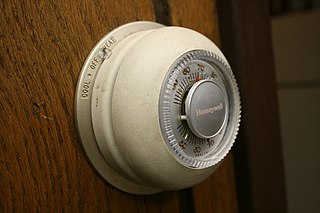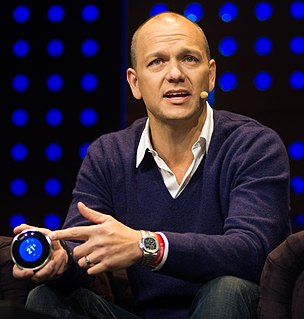
Honeywell T87 Round Thermostat is a thermostat that Honeywell International, Inc. first manufactured in 1953. [1] Henry Dreyfuss designed the thermostat based on a concept by Honeywell engineer Carl Kronmiller. [2]

Honeywell T87 Round Thermostat is a thermostat that Honeywell International, Inc. first manufactured in 1953. [1] Henry Dreyfuss designed the thermostat based on a concept by Honeywell engineer Carl Kronmiller. [2]
Honeywell International Inc. is an American publicly traded, multinational, conglomerate company headquartered in Charlotte, North Carolina, United States composed of four Business Groups—Aerospace, Building Technologies, Performance Materials & Technologies (PMT), and Safety & Productivity Solutions (SPS)—which produce aerospace systems, industrial products, and engineering services.

A thermostat is a component which senses the temperature of a physical system and performs actions so that the system's temperature is maintained near a desired setpoint.

Anthony Michael Fadell is an American engineer, innovator, designer, entrepreneur, founder, coach, and active investor. The "father of the iPod", he joined Apple Inc. in 2001, served as the Senior Vice President of the iPod division at Apple Inc. and oversaw all iPod hardware, software, and accessories development and iPhone hardware, firmware, and accessories development from March 2006 to November 2008. He is also a co-creator of the iPhone, working on the first three generations of the iPhone. In May 2010, he co-founded Nest Labs, which announced its first product, the Nest Learning Thermostat, in October 2011. Nest was acquired by Google in January 2014 for $3.2B. He resigned from Google in June 2016. Fadell is the Principal at Future Shape, a global investment and advisory firm coaching 200+ startups working on foundational deep technology.

Henry Dreyfuss was an industrial design pioneer. Dreyfuss is known for designing some of the most iconic devices found in American homes and offices throughout the twentieth century, including the Western Electric Model 500 telephone, the Westclox Big Ben alarm clock, and the Honeywell round thermostat. Dreyfuss enjoyed long term associations with several name brand companies such as John Deere, Polaroid, and American Airlines.
A humidistat is an electronic device analogous to a thermostat but which responds to relative humidity, not temperature. Humidistats are used in a number of devices including dehumidifiers, humidifiers, and microwave ovens. In humidifiers and dehumidifiers the humidistat is used where constant relative humidity conditions need to be maintained such as a refrigerator, greenhouse, or climate-controlled warehouse. When adjusting the controls in these applications the humidistat would be what is being set. In microwaves they are used in conjunction with "smart cooking" one-button features such as those for microwave popcorn. Humidistats employ hygrometers but are not the same. A humidistat has the functionality of a switch and is not just a measuring instrument like a hygrometer is.
Mark Charles Honeywell was an American electronics industrialist. He founded the eponymous Honeywell and was its first president and CEO (1927–1933).
A zone valve is a specific type of valve used to control the flow of water or steam in a hydronic heating or cooling system.

A programmable thermostat is a thermostat which is designed to adjust the temperature according to a series of programmed settings that take effect at different times of the day. Programmable thermostats are also known as setback thermostats or clock thermostats.

The Honeywell Center in downtown Wabash, Indiana, United States, is located 47 miles (76 km) southwest of Fort Wayne, Indiana. It's a block-long arts complex featuring the Ford Theater, Clark Gallery, and Eugenia's Restaurant. The Ford Theater presents Broadway, rock, country, classical, and comedy performances.
Albert Butz (1849–1905) Swiss born inventor and businessman who immigrated to the United States in the 1850s and founded the Butz Thermo-electric Regulator Company that, through a series of re-organizations, name changes, and mergers, became Honeywell, Incorporated.
William Richard Sweatt (1866–1937) was an American industrialist.
T87 or Type 87 may refer to:
An aquastat is a device used in hydronic heating systems for controlling water temperature. To prevent the boiler from firing too often, aquastats have a high limit temperature and a low limit. If the thermostat is calling for heat, the boiler will fire until the high limit is reached, then shut off. The boiler will re-fire if the boiler water temperature drops below a range around the high limit. The high limit exists for the sake of efficiency and safety. The boiler will also fire when the boiler water temperature goes below a range around the low limit, ensuring that the boiler water temperature remains above a certain point. The low limit is intended for tankless domestic hot water---it ensures that boiler water is always warm enough to heat the domestic hot water. Many aquastats also have a differential ("diff") control which determines the size of the range around the "low" and/or "high" controls.
Honeywell Aerospace is a manufacturer of aircraft engines and avionics, as well as a producer of auxiliary power units (APUs) and other aviation products. Headquartered in Phoenix, Arizona, it is a division of the Honeywell International conglomerate. It generates approximately $10 billion in annual revenue from a 50/50 mix of commercial and defense contracts.
OpenTherm (OT) is a standard communications protocol used in central heating systems for the communication between a central heating boiler and a thermostatic controller. As a standard, OpenTherm is independent of any single manufacturer. A controller from manufacturer A can in principle be used to control a boiler from manufacturer B. However, OpenTherm controllers and boilers do not in fact always work properly together. The OpenTherm standard comprises a number of optional features and some devices may include manufacturer-specific features. The presence or absence of such features may impair compatibility with other OpenTherm devices.

Smart thermostats are thermostats that can be used with home automation and are responsible for controlling a home's heating and/or air conditioning. They perform similar functions as a Programmable thermostat as they allow the user to control the temperature of their home throughout the day using a schedule, but also contain additional features, such as sensors and WiFi connectivity, that improve upon the issues with programmable thermostats.

Google Nest is a brand of Google LLC used to market smart home products including smart speakers, smart displays, streaming devices, thermostats, smoke detectors, routers and security systems including smart doorbells, cameras and smart locks.
CP-6 is a discontinued computer operating system developed by Honeywell, Inc. in 1976. It was a backward-compatible work-alike of the Xerox CP-V fully rewritten for Honeywell Level/66 hardware. CP-6 was a command line oriented system. A terminal emulator allowed use of PCs as CP-6 terminals.
The Mercoid cases—Mercoid Corp. v. Mid-Continent Investment Co., 320 U.S. 661 (1944), and Mercoid Corp. v. Minneapolis-Honeywell Regulator Co., 320 U.S. 680 (1944)—are 1944 patent tie-in misuse and antitrust decisions of the United States Supreme Court. These companion cases are said to have reached the "high-water mark of the patent misuse doctrine." The Court substantially limited the contributory infringement doctrine by holding unlawful tie-ins of "non-staple" unpatented articles that were specially adapted only for use in practicing a patent, and the Court observed: "The result of this decision, together with those which have preceded it, is to limit substantially the doctrine of contributory infringement. What residuum may be left we need not stop to consider." The Court also suggested that an attempt to extend the reach of a patent beyond its claims could or would violate the antitrust laws: "The legality of any attempt to bring unpatented goods within the protection of the patent is measured by the antitrust laws, not by the patent law."
| This technology-related article is a stub. You can help Wikipedia by expanding it. |